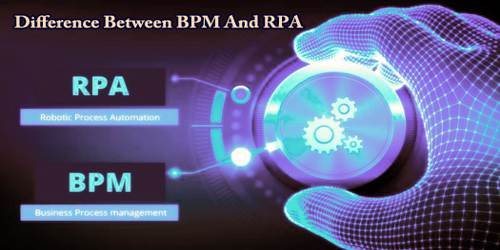For many years, business process management (BPA) has been a fundamental part of organizations’ digital transformation strategies. However, as technology advances, the digital age requires rethinking the role of BPM in organizations. In addition, many technologies such as big data, social media, Internet of Things, artificial intelligence, have come to the fore in recent years, which opened up a new window of opportunities for these organizations to become technology-ready in this competitive digital era. This is where Robotic Process Automation (RPA) comes to the picture. However, RPA does not replace BPM but rather complements it. Each suited to automating different types of processes.
Definition of Business Process Management (BPM) –
Business Process Management (BPM) is a strategic approach that concentrates on reshaping an organization’s existing business processes to achieve optimal efficiency and productivity. BPM software is the foundational backbone to facilitate the completion of an organization’s projects, providing a variety of tools to help improve and streamline how business processes are performed. BPM software components can include business analytics, workflow engines, business rules, web forms, and collaboration tools. Often large-scale projects, BPM process improvement initiatives can impact an organization’s technology, employees, and customers, bringing about significant transformational returns.
Information Technology (IT) plays a major role in driving innovation in today’s digital world, and BPM is the key in leveraging these potentials. BPM can be considered as a key driver for innovation. It is more of a methodology that provides the management team and the organization as a whole with a clear perspective on how things should be done. It simply is a means to automate operations in order to gain control and manage organizations’ core business processes.
Definition of Robotic Process Automation (RPA) –
Robotic Process Automation (RPA) is a software technology that enables employees to better focus on high priority tasks by pushing routine, monotonous tasks to software “robots” to complete. These robots work directly across application user interfaces, automatically inputting data and triggering actions across multiple systems acting on the behalf of an employee. As a business user-friendly tool that does not involve any programming, robotic process automation technology enables non-technical professionals to self-serve and configure robots for themselves to solve their own automation challenges.
Well, RPA is not entirely a new concept; for years, people have been programming scripts to download data from websites or using recorders to record mouse-clicks. However, it is only recently were all these capabilities have been built into a product. It is basically a technology to formulate digital strategies through automation of rule-based, repetitive, and predictable tasks in combination with structured and stable data.
Key difference between BPM and RPA –
Both the technologies (BPM and RPA) deal with automation and both are being increasingly used in digital transformation. Each business has a series of tasks, events, and decisions that move work from start to completion through business processes. BPM is a holistic approach to optimize and automate business processes, while RPA deals with discreet, repetitive tasks. These tasks typically occur at the start of a process, so RPA can play a significant role in automating these. BPM is end-to-end, so while RPA can be part of a BPM approach, it will not replace BPM.
- Technology – Business process management (BPM) is a discipline in operations management that helps organizations business agility via process automation, control, execution, and optimization. It encompasses a wide range of software technology components to help organizations achieve strategic business goals by integrating digital technology into all areas of their business operations. Robotic Process Automation (RPA) is basically a software technology to formulate digital strategies through automation of rule-based, repetitive, and predictable tasks that humans would have to do otherwise.
- Automation – Although each suited to automating different types of processes, one does not replace the other; they rather complement each other. In BPM, the processes may be automated, but the answer to process improvement is not necessarily always process automation. While it does incorporate automation, this is not the sole purpose of BPM. The general idea of RPA, on the other hand, is that software robots perform formerly human work. People still can automate processes that have human elements in them, just not completely. RPA is what we can call assisted automation.
- Role – There are many different ways in which BPM can serve as a source of innovation. BPM can drive innovation in two ways: One, through managing processes that yield product innovations, such as processes in the R&D department, and second, through incorporating new technologies into organizational processes to foster process innovations. A major selling point for the adoption of RPA is, of course, the reduction in cost. In addition, the robot is going to do exactly what you tell it to do with less or no human participation and in less time possible with maximum accuracy and efficiency.
- Implementation – BPM orchestrates the different processes in an organization by automating automatic tasks either using integration with other systems or through integration with other tools, and other tasks that require human participation. Therefore, implementing BPM is necessary when we speak of process automation, which requires participation from both humans and machines, and in which there is some decision-making. RPA, on the other hand, is meant to use where there is a high volume of repetitive tasks and types of processes in which human intervention is not necessary and there is no decision-making.
Actually, BPM and RPA are essentially the buzzwords across the modern enterprise domain, both concerning process automation and long term digital transformation. BPM, as a concept, is a comprehensive approach to automate crucial business processes in order to gain better market results and work efficiencies. On the other hand, RPA is the automation of repetitive and monotonous tasks to better focus on core business areas and invest the resources towards development excellence. With BPM, businesses can enable End-to-End process automation, thereby improving overall team performance and development quality. Whereas, RPA is targeted to automate repetitive yet business crucial processes, in order to assign intelligent resources on development processes.
Well, in a nutshell, BPM is necessary when we speak of process automation, which requires participation from both humans and machines, whereas RPA is useful where there is a high volume of repetitive tasks and types of processes in which human participation is not necessary. Besides, the general idea of RPA is that software robots perform formerly human work. While BPM does incorporate automation, this is not the sole purpose of BPM.
Information Sources:















